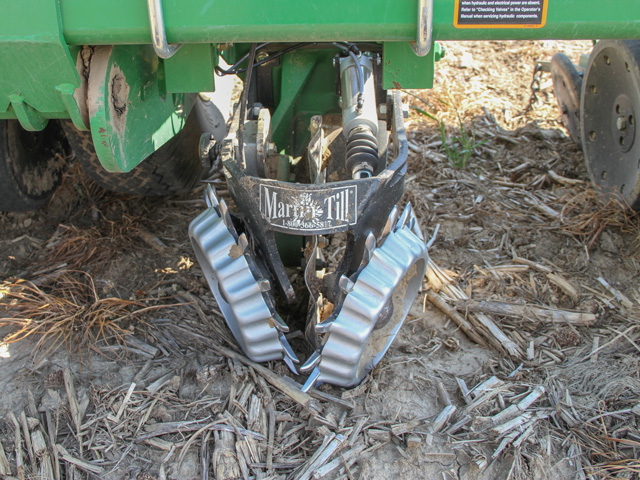4 Planter Upgrades to Consider in 2025
Increase Performance of an Existing Planter With Technology Upgrades
JEFFERSON CITY, Mo. (DTN) -- While many farmers already have their seed and other crop inputs ordered by January, what equipment they'll be pulling across the field to plant that crop may still be undecided for 2025. Some may be in the market for a brand-new planter. Others may be looking to upgrade their current one, while yet another group is staying the course with what's already in the shed.
"Every farmer and every planter is different," said Doug Houser, Iowa State University Extension specialist and member of the team at ISU's Digital Ag Innovation Lab. "You've got to start by asking yourself what your goals are and then just make sure that you do anything and everything you can to have an efficient planting season."
UPGRADE OPTIONS
In a recent ISU blog post, Houser outlined four planter technology upgrades for farmers to consider. They include: downforce systems with sensing and/or active control; electric drive seed meters and high-speed seed delivery systems; row cleaners; and closing wheels. Read the full blog here: https://crops.extension.iastate.edu/….
While each of these upgrades can improve a planter's performance, they address different aspects of the planting process. During an interview with DTN, Houser said farmers should consider what factors limit their success when planting and then select the appropriate solutions to overcome those factors.
"For instance, if my limiting factor is time -- that I need to go faster and get across more acres with one planter because I can't afford a second one -- then I'd probably be looking at upgrading my seed meters," he explained. "If I have a lot of variability in my soil types or field conditions, and that's causing issues with my row units and their ability to create a good furrow, then maybe a downforce system might be my biggest payoff. If my problem is one of uneven crop emergence, row cleaners and closing wheels might be the best solution."
P[L1] D[0x0] M[300x250] OOP[F] ADUNIT[] T[]
Of course, the most limiting factor for a planter upgrade may be the funds available for the project. Houser said if he was really trying to drive planter efficiency, he'd begin by upgrading seed meters, followed by row cleaners, then downforce systems and finally closing wheel options.
He added that farmers should consider if their current tractor/planter setup can accommodate the technology upgrades they're planning -- and if those upgrades complement each other.
"As you add components, you're likely both adding weight and increasing demands on horsepower, hydraulic systems, electrical systems and even the structural strength of the planter frame," Houser said. "So, you must be cognizant of that. Also, I try to stay within one brand 'ecosystem' when adding components, just because I know they'll have been tested and designed to work together."
NEW PAINT POSSIBILITIES
While buying a new planter may not seem feasible for some in 2025, Houser said farmers shouldn't assume that upgrading an existing planter is going to be the cheaper option. Many, especially those who've been waiting to invest in new equipment, may find a favorable purchase environment this season.
"Before I go buying a bunch of components to hang on my old planter, it might be a good time to at least kick the tires and meet with some dealers on what kinds of programs they have because right now, prices are down," he said. "If a dealer has inventory they need to move, I might get a better deal on a new planter outfitted with everything I'm wanting."
MAINTENANCE MATTERS
Even if upgrading or buying new aren't options for 2025, Houser noted that a farmer's current planter can still be improved with some simple maintenance. Spending a few winter days in the shop going through each row unit, replacing worn out parts and making adjustments can lead to extra bushels in the grain tank at harvest.
"Hanging bells and whistles on a planter is great, but it's no replacement for proper maintenance," Houser said. "Check anything that wears -- the bushings, the bearings, the openers, the seed scrapers -- and replace or adjust them as needed. Adjust the gauge wheels and calibrate planting depth. Make sure the closing wheels are aligned correctly to ensure proper furrow closure."
Finally, be sure to update monitor firmware and other software programs.
"You don't want to hit the field for the first time in 2025, turn your monitor on and get a message that says, 'update needed,' because you'll likely be on the Back 40 with no Internet," Houser added.
For the fourth consecutive year, ISU is offering Planter University at six locations across Iowa in February. The one-day session offers a brand-neutral, hands-on opportunity to learn more about planter technologies and optimizing planter setups. The cost is $100 per person. To learn more, go to: https://www.regcytes.extension.iastate.edu/….
Jason Jenkins can be reached at jason.jenkins@dtn.com
Follow him on social platform X @JasonJenkinsDTN
(c) Copyright 2025 DTN, LLC. All rights reserved.






